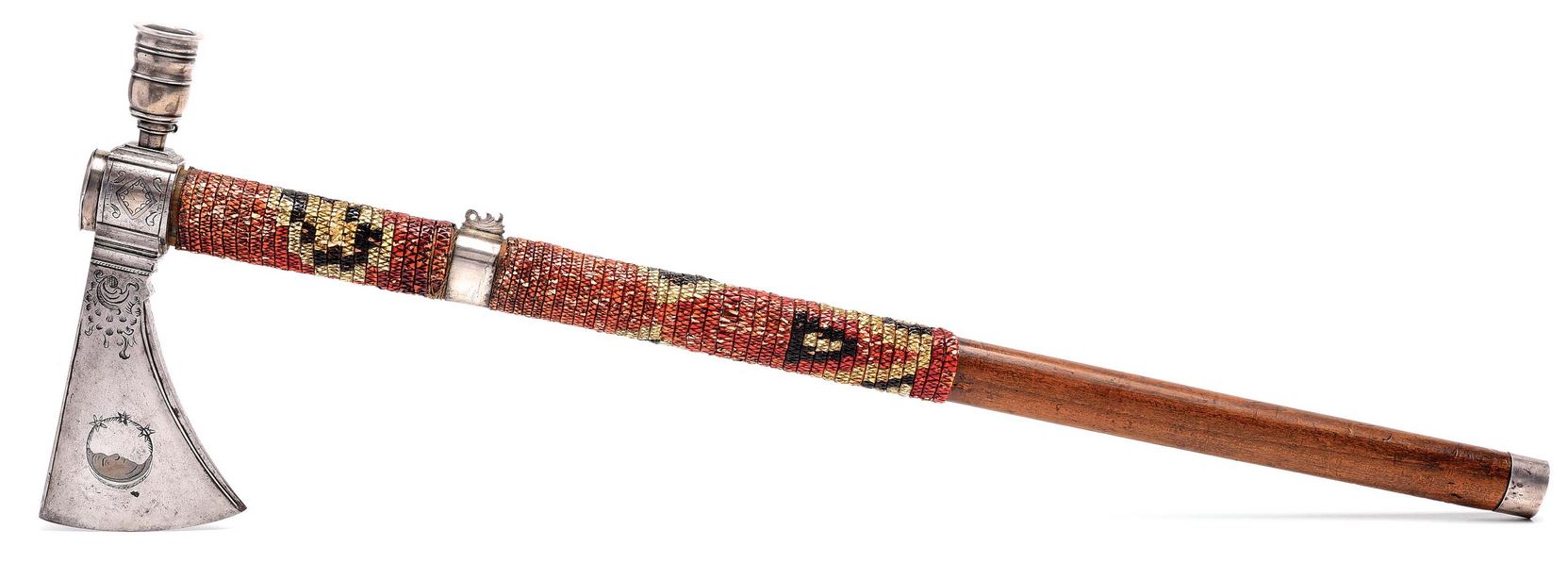By Greg Smith
DENVER, PENN.— An auction record for any tomahawk was set at Morphy Auctions on May 27 as a Revolutionary War presentation pipe tomahawk made by future General Richard Butler and inscribed to Lieutenant John McClellan, circa 1765-1770, sold for $664,200, including buyer’s premium, to an American buyer.
Auctioneer Dan Morphy called it “arguably the most important, most historic, most well decorated and best known American tomahawk in existence.”
The tomahawk began bidding at $240,000 and was at $400,000 within 20 seconds of fast action. The firm had six phone lines bidding on it.
It features a maple haft with two sections of period Shawnee porcupine quill work in red, black and white dyes. The hand forged head features a silver bowl and is engraved to both sides: one with a “shell design at the top and an engraved sun in splendor with a silver engraved inlay as the center, the other side shows an engraved inlaid half moon with a face surrounded by other engraved designs.”
The tomahawk is illustrated in Indian Tomahawks & Frontiersman Belt Axes (Hartzler and Knoles), Clash of Empires: The British, French & Indian War, 1754-1763 (R.S. Stephenson), American Adversary West and Copley in a Transatlantic World (Museum of Fine Arts, Houston), and Masterpieces of American Indian Art from The Eugene And Clare Thaw Collection.
Richard Butler was born in Ireland in 1743 and moved with his family to Lancaster, Penn. He began his training under his father, who established a gun shop in Carlisle, Penn., which still stands. He was the armorer at Fort Pitt between 1765 and 1770, and his log book in the collection of the Carnegie Library says he created many pipe tomahawks during his time there. In 1772, he was commissioned as a Captain in the Pennsylvania Militia, during which time he became acquainted with the Native American community in Pennsylvania and offered them gunsmithing and fur trading services. He resigned as Captain in 1775 and became an Agent of Indian Affairs for the region and was responsible for negotiating the Treaty of Neutrality. In 1776, Butler was commissioned as a Major in the Continental Army’s 8th Pennsylvania Regiment. He fought at Monmouth, Saratoga, and Valley Forge, and is listed as a Colonel at Yorktown. In 1783, Butler was promoted to Brevet Brigadier General.
Following the Revolutionary War, Butler went on to further his work with the Native Americans on behalf of the Confederation Congress. In 1785, Butler took part in the Treaty of Fort McIntosh, which resulted in a great swath of land in southern and eastern Ohio relinquished from Native American control. Some of the tribes called the treaty illegitimate, and Butler again went out in 1786 to negotiate with the Shawnee, which resulted in the Treaty of Fort Finney, which stripped them of their land in southwestern Ohio and Southern Indiana.
Butler was commissioned in 1791 as a Major General under Major General Arthur St. Clair, which would lead to his death at St. Clair’s Defeat at the base of the Wabash River in 1791. When the Western Confederacy of Native Americans came down by surprise on U.S. troops on November 4, the annihilation wiped out one fourth of the U.S. army at the time. Only 24 of the 920 officers and men were unscathed, with 632 killed and 264 wounded. Thirty-nine officers of the 52 engaged there were killed on the field.
Three Butler Counties are named for Richard Butler, including those in Kentucky, Pennsylvania and Ohio. The city of Butler, Penn., is named for him as well, as is the General Richard Butler Bridge in that city.
Lieutenant McClellan, for whom the tomahawk was made, lived outside of Carlisle, Penn. He was a rifleman, a position that was required to carry a tomahawk as their rifles did not have fittings for bayonets. He was a first Lieutenant in Company D of Thompson’s Battalion of Pennsylvania Rifleman.
McClellan died on his way to the Battle of Quebec in October of 1775, which logs recount as a grueling march for all involved. He reportedly died following the capsizing of his bateau in a river. His brother Daniel McClellan took the tomahawk and continued up to Quebec, where he was taken prisoner by the British.
An officer plundered the tomahawk and it made its way to England. The tomahawk was purchased by George Greville (1746-1818), the Earl of Warwick for his collection at Warwick Castle. It remained there for over 200 years.
In 1997, the tomahawk was sold at Sotheby’s in New York to Dave Kleiner, who sold it to Gordon Barlow, who sold it to Kelly Kinzle, who sold it again into an esteemed collection.
Kinzle called it “the most significant Eighteenth Century tomahawk in existence” and “a Revolutionary War icon.”
Kinzle said that it was really the dealer Steven Hench who did the bulk of the research on it and discovered its importance.
A full review of Morphy’s May 27 “Founders & Patriots” auction will appear in a future issue.





